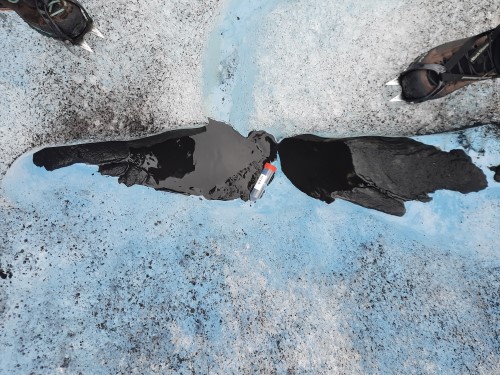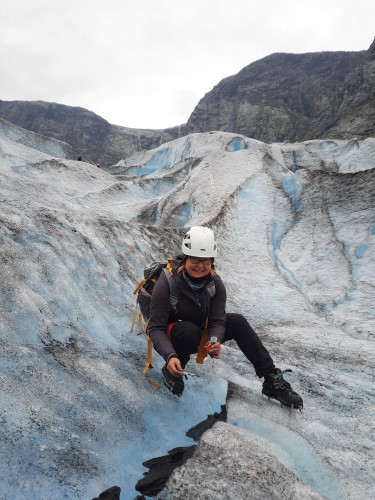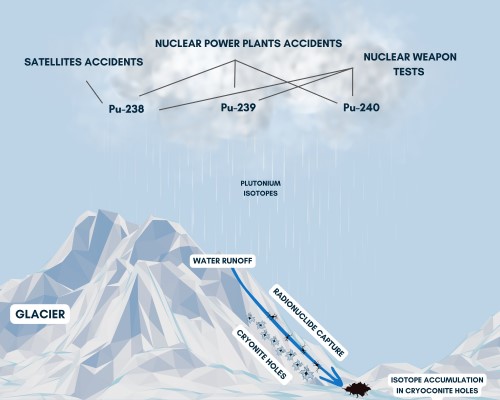Plutonium isotope anomalies on the Southern Hemisphere glaciers
12 December 2024
EurekAlert!: [https://www.eurekalert.org/news-releases/1068038]
The results of the newest investigations carried out by scientists from the Institute of Nuclear Physics PAN shed new light on the processes of accumulation of plutonium isotopes on glaciers of the Southern Hemisphere. Analyses of samples of cryoconite, a sediment that accumulates on glaciers, reveal not only differences in concentrations between the hemispheres but also indicate unprecedented isotope anomalies that may be related to accidents such as the fall of the Mars-96 spacecraft.
Glaciers do not only add majestic charm to the mountain landscape, but they also play a vital role in fresh water supplies. Their melting, caused by global warming, may have serious consequences - from sea level rise to the reduction of water resources that are of key importance for the production of energy in hydro-electric power stations. Additionally, radionuclides and other contaminants that are released from the ice may migrate to the nearby ecosystems, where they may accumulate and affect the food chain.
Radioactive elements are present in the environment as a result of natural processes and human activity. Artificial radionuclides, such as plutonium, are released into the environment mainly through nuclear tests, reactor accidents or failures of satellites and space probes containing radioactive sources of energy. These substances, transported mainly through the atmosphere, accumulate in different ecosystems, including glaciers, in the form of dark sediments called cryoconite. A typical cryoconite hole is no more than a few dozen centimeters in diameter and depth. At its bottom, there is a dark sediment called cryoconite. It contains organic material and contaminants, i.e. radionuclides, heavy metals, pesticides, microplastics, or antibiotics. This sediment may pose a potential threat to local ecosystems.
The newest investigations conducted at the Institute of Nuclear Physics of the Polish Academy of Sciences (IFJ PAN) with the use of novel methods of mass spectrometry allowed researchers to create a database for plutonium isotopes (238,239,240Pu) in the glaciers of the Northern and Southern Hemispheres. The analyzed samples of cryoconite come from 49 glaciers of nine regions of the world, including the Arctic, Alpes, Himalayas, and Antarctica. The material was collected by an international team of researchers over the years 2000-2020, and the studies were financed from a National Science Centre project.
„These are the first analyses of plutonium concentration in cryoconite samples carried out on such a large scale
” - says Dr. Edyta Łokas (IFJ PAN), the initiator and first author of the article published in Science of the Total Environment.
The results of the study have provided unique information about the accumulation, distribution and sources of plutonium isotopes in glaciers. The concentration of 239+240Pu activity turned out to be much higher in the Northern than the Southern Hemisphere, which reflects an uneven deposition of Pu coming from nuclear weapon tests between the hemispheres. As for the Northern Hemisphere, the highest concentrations are observed in Scandinavia and the Alps. No relevant differences have been noticed between the hemispheres in the case of 238Pu. The cryoconite from the southern hemisphere is characterized by high heterogeneity in terms of both Pu activity and mass ratio.
The isotope ratios of 238Pu/239+240Pu, so far unprecedented in the literature, have been for the first time observed in the cryoconite of the Exploradores Glacier in Patagonia. Researchers hypothesize that the excess of 238Pu may be related to the fall of the Soviet space probe MARS-96, which sank in the ocean off the coast of Chile in 1996. The space probe contained a generator with 238Pu, which may explain higher concentrations of this isotope on the nearby glacier. The results of the study are the first observations of their kind showing anomalies in plutonium isotope ratios in the Southern Hemisphere.
Additionally, the cryoconite samples from South American glaciers demonstrated 240Pu/239Pu mass ratios significantly deviating from those found in the literature, which may suggest that the dominant source of Pu is related to low-altitude nuclear tests conducted in the area of French Polynesia.
“The concentrations of plutonium activity in the cryoconite that we have observed are - especially in the Northern Hemisphere - orders of magnitude higher than in other environmental matrices used to monitor the environment, such as lichen, moss, soil, and sediments. Simultaneously, our discoveries emphasize the importance of cryoconite in the accumulation of radioactive contaminants that may pose a potential threat to the surrounding fauna and flora, and at the same time they may help us to track the diffusion of those pollutants
” - notes Dr. Edyta Łokas.
The group of researchers from IFJ PAN continue their work. The next investigations, conducted in cooperation with the AGH University in Kraków, took place at the ice cap of Jostedalsbreen in Norway. The expedition, organized in August 2024, aimed at better understanding the processes of contaminant accumulation in glaciers and their sources.
[PDF]
Contact:
Dr. Eng. Edyta Łokas
Institute of Nuclear Physics, Polish Academy of Sciences
tel.: +48 12 662 8152
email: edyta.lokas@ifj.edu.pl
Scientific papers:
„Isotopic signature of plutonium accumulated in cryoconite on glaciers worldwide”
E. Łokas et al.
Science of The Total Environment, 951 (2024) 175356
DOI: http://dx.doi.org/10.1016/j.scitotenv.2024.175356



